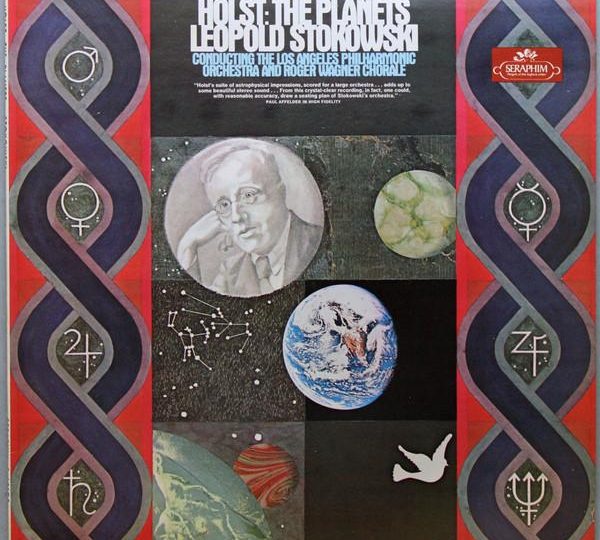
Gustav Holst’s Groundbreaking Symphonic Textures in The Planets (1916)
Gustav Holst (born September 21, 1874, died May 25, 1934) was a British composer who became fascinated with astrology in 1913. In the spring of 1914, prophetically before the outbreak of World War I that summer, Holst composed the first of seven pieces for his orchestral suite The Planets– “Mars, the Bringer of War”. In 1913, Russian composer Igor Stravinsky shocked the public with the radical rhythms in his Rite of Spring, provoking riots in Paris. Alongside Stravinsky’s Rite of Spring, Holst’s Planets is the most important symphonic music of the 20th century. “Mars, the Bringer of War” is clearly influenced by Stravinksy’s Rite of Spring. However, while Stravinsky was depicting ancient sacrifice in Rite of Spring, Holst goes much further. “Mars, the Bringer of War” is an agitated allegro and is distinctly modern, its sounds are much more violent than Stravinsky’s Rite of Spring-explosions, grenades, machine guns, tanks, trenches- all of the grotesque horrors of the imminent World War I are displayed in its ferocity. The most remarkable recording of The Planets (its first recording in stereo) was conducted by the fiery Leopold Stokowski during the post-World War II prosperity of the 1950s in 1956 with the Los Angeles Philharmonic Orchestra. “Mars, the Bringer of War” has remained the most imitated of Holst’s pieces for The Planets– its militarism had an impact on heavy metal (Tony Iommi’s guitar riff for the title track of Black Sabbath’s debut and Bill Ward’s percussion on “Children of the Grave“) and was ripped off by John Williams (Star Wars, Indiana Jones, etc.) and countless other movie soundtracks.
“Venus, the Bringer of Peace” shows Holst’s dynamic range as he moves, in complete contrast, from the dramatic intensity of the battlefield to a bucolic, nostalgic, pastoral paradise. The sensual and serene sounds are reminiscent of Nikolai Rimsky-Korsakov’s exotic Scheherezade and Claude Debussy’s own pastoral Prelude to the Afternoon of a Faun. “Venus” is adagio, andante. “Venus” contains the calm call of flute, harp, oboe and violin. Ancient fountains and grottoes, breezes, blue skies, and cumulus clouds, the fullness of grapes, a goddess in a gown reclining beneath the shade of an arbor of trees during a spring or summer afternoon- all of the images recall Greco-Roman art or the animation for Beethoven’s Pastoral Symphony (from Walt Disney’s Fantasia, where Leopold Stokowski was also the conductor).
“Mercury, the Winged Messenger” is challenging and difficult to write about because it is the most rapid and shortest. “Mercury” is the last piece Holst composed for The Planets and is vivace- it is all motion, speed, travel. “Mercury” and “Jupiter” are, in my opinion, the least interesting pieces of Holst’s Planets.
“Jupiter, the Bringer of Jollity” is an exuberant allegro and presto and shifts back and forth between a high energy, galloping dance and a noble waltz. Because “Jupiter” is the most traditional of Holst’s pieces (and the most aristocratically English), it was, unfortunately, used as the melody for a patriotic English hymn that became enormously popular in the 1920s-1930s and was sung by soldiers as they entered an even worse war, World War II, in the 1940s. (It is still used today for macho, masculine sports events.)
If, like me, you are listening to The Planets on vinyl on a turntable, then, like me, you breathe a sigh of relief when the bombastic “Jupiter” has ended and side one spins to a stop. This is because side two is where Holst really shines and shows his innovations. “Saturn, the Bringer of Old Age” was Holst’s own personal favorite of his pieces he composed for The Planets. It is complex, melancholy, profound, and sorrowful. “Saturn” is, like “Venus”, adagio and andante, but where “Venus” was youth, the nearly eight minutes (eight is numerologically Saturn’s number) of Saturn is the slow decay of middle age, old age, and death. Where “Venus” was spring and summer, “Saturn” is autumn and winter. The alarming church bells clanging are a funeral, but the majestic moments after this are drifting, falling, golden leaves and silvery snowflakes- time is transcended.
“Uranus, the Magician” is akin to the “Dream of A Witches’ Sabbath” from Hector Berlioz’s Symphonie Fantastique– macabre madness. The same way that “Mars” heavily influenced both action/adventure/war movie soundtracks and the heavy metal genre, “Uranus” obviously had an effect upon horror film soundtracks.
Holst saves his greatest piece of music for last. “Neptune, the Mystic” is my favorite piece of orchestral music (alongside Claude Debussy’s “Sirenes” and Maurice Ravel’s “Lever du Jour”). The celeste and swirling strings (the strings anticipate Ligeti’s later experiments) create a music mysterious and otherworldly- it truly sounds like the faraway depths of outer space. The voices of the female choir are ethereal and haunting. Many music historians and scholars consider this ending to be the first “fade-out” in music history.
Gustav Holst’s The Planets had its first complete public performance in 1920. It has influenced music for a century and, 100 years later, its symphonic textures are still groundbreaking.
by Mark Lager

Beautifully written article on a few composers I should probably know better. This will give me a great place to start looking. And listening.
Thank You Shawn.
Hi guys, love your website. Great writing and content, keep up the good work!
Sending positive vibes! – Frank
Thank You Frank.
Great read, Mark!. Nice to see you back on VW.
I’m also interested in classical music, and it’s great to know more about Holst and The Planets. It’s rare to see extended and informative reviews about classical music, there’s many things I didn’t know about the symphonic suite.
“Mars, the Bringer of War” is possibly my favorite piece.
Thank You Octavio.
Surprising to see this here. I discovered these great pieces of music in school. Do you know Tomita’s synthesizer version of this complete album, from the 70s? I dig it most tbh!
Julian,
What are your favorites? My favorites are “Venus, the Bringer of Peace”, “Saturn, the Bringer of Old Age” and “Neptune, the Mystic”.
Interesting background story! Wasn’t this also used in “Gladiator” ?
Marc,
Yes–Hans Zimmer ripped off “Mars, the Bringer of War” for Gladiator. I think I remember reading that the Gustav Holst estate either filed a lawsuit or threatened to.
It makes you think of Star Wars and Star Trek right away!
Ulrich,
John Williams obviously ripped off “Mars, the Bringer of War” for the Imperial March in Star Wars.
You keep on using “ripped off” as if borrowing musical elements introduced by new composers is a bad thing. Something that Holst did himself as you noted by his influences from Beethoven, Debussy, etc.
Gustav Holst (he couldn’t have a more German name) is new to me and I’m generally not used to read good articles on good classical music, articles that can put the music in a context historically and by means of their influence. You can build the bridge between Holst and Sabbath, and that is something that I love.
You can totally hear how Holst has been ripped off by countless film music composers. The changes and contrasts in the music are thrilling , “from the dramatic intensity of the battlefield to a bucolic, nostalgic, pastoral paradise”. The images you evoke to certain suites is beautiful “The alarming church bells clanging are a funeral, but the majestic moments after this are drifting, falling, golden leaves and silvery snowflakes- time is transcended.”
“Neptune” is outstanding- otherworldly, extraterrestrial, floating into infinity.
Great article, thank you.
Do you know why he only used 7 planets?
Saliha,
I appreciate that you are interested in this symphonic suite. Earth is not one of the planetary patterns in astrology and Pluto had not been discovered yet so that is why Holst only composed music for seven planets.
“Mars” is the most famous and imitated and “Jupiter” is popular, but I think the most innovative, inspiring pieces are “Venus”, “Saturn”, and, most of all, “Neptune”.